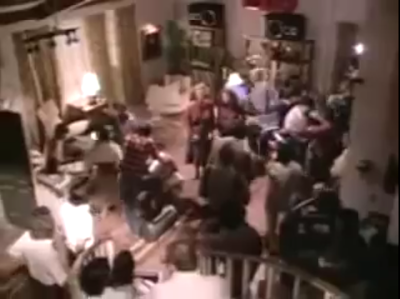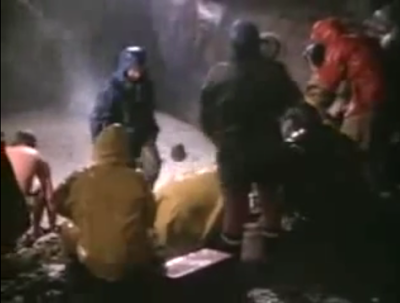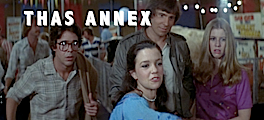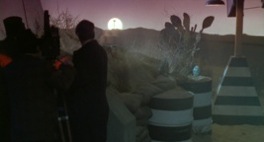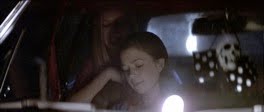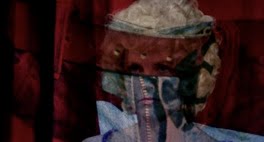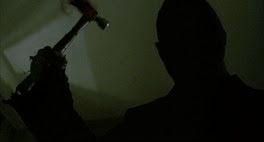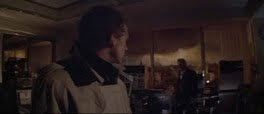... the Making of Poltergeist featurette.
It begins with Steven Spielberg describing to a member of the FX team his idea behind one of Poltergeist's ghostly manifestations. Now it's hard to be immediately sure what scene he is referring to, as between script, film, and on-set discussion, there exists major discrepancies - but through context clues it can be deduced. We can be fairly certain Spielberg is referring to the "staircase scene" that occurs midway through the film, in which a manifestation descends the curved staircase of the house and then shoots into the living room ceiling, or the much-emphasized "area of bilocation" (as Spielberg refers to it in his verbal description). A minor confusion arises, though, when one focuses on how the scene changed further in deliberations, resulting in the scene as it exists in the film. At this point, Spielberg describes a "transition" from the classical ghost - which Spielberg refers
to, accurately, as it appears in the film, as a "she" - to the threatening monster, the beast, that is to "grow out of her." At some future point, the decision was made to nix the need for the beast to be revealed at this point, and so the scene consists solely of the ethereal female ghost descending the staircase before dissipating into the air below the ceiling. I make a point of this just to illustrate the extreme atmosphere of creativity as well as contingency that seems to have characterized the Poltergeist set. This is a natural extension of a film of incredible on-set spontaneity and collaboration, one that consists of two auteurs - or at least, one "idea man" and one realisateur, director, scene-setter, or "metteur en scene" - as well as the "auteurism" of numerous make-up artists, effects designers, and technical designers that worked to create a film of such extravagant fantasy and inspiration.
More FX-knowledgeable people may have a better idea than I have, but at some point the decision had to have been made to limit the appearance of the staircase apparition, perhaps a wise decision to cut down the Beast's appearance to only once in the film so as not to dilute its impact. I presume the optical imagery of the shrouded ghost was filmed at some point removed from the filming of the characters in the living room witnessing it - shots of astonished faces, the special effect of the "blinding white light," and the wide shot of all the characters surrounding the ghostly vision shot on the set on the appointed day, while the actual ghost was shot on a completely different day, and a matte or superimposition process is how the finalized image was brought to life. Now how the principal shooting of the actors in the room was shot must have some bearing on how the ghost would be actually imagined. At what point Spielberg realized the shortcoming of the enthusiastic description he offers at the beginning of this featurette - that having the ghost semi-transform into the beast was much more than necessary, that putting that much effort into an elaborated transformation would complicate what should be a much more loose, ambiguous, and simple episode, which is how it now exists in the film - is up in the air, and whether Hooper's alterations to the scene in principal shooting had any impact on what may have been a joint decision to jettison the appearance of the beast here is also up in the air. What bears emphasizing is, outside of Spielberg directing the actors on the set for this scene himself, a discussion between Spielberg and Hooper must have occurred to divert from such strong envisioning of the moment from Spielberg himself. There is also the chance, though, that the transformation was shot, then removed. There's also the chance that Spielberg himself realized the difficulty of imagining this Beast "growing out" of the ghostly female figure, then animating it, and he nixed it soon after he suggested it. But there's always the niggling factor of how Hooper shot the scene, sans ghost, and the thus necessarily collaborative element in simplifying the phantom to the strictures of Hooper's staid wide-shot of the living room, of figures not abound in terror but standing stock still for the mere witnessing of something unidentifiable rather than outright threatening. In any case, Spielberg had to agree at some point on the quelling of his initial instinct, which is to throw everything he's got into the initializing of narrative stakes and plot-friendly, audience-friendly clarity. The threatening monster that "grows out" of the ghost fulfills the logic Spielberg speaks of at the very beginning of the featurette: tangible and literal, in-your-face "spirits" that can serve as concrete stimuli for the audience, the threatening beast made clear to be housed within the ethereal spirit. For Spielberg, the dots should be connected for the audience, some of whom may be left wondering what the connection is between any old otherworldly vision and the what-it-is exactly that Carol Anne was running away from on the Other Side.
If we put two and two together about Spielberg's envisioning of the Beast - which includes the imagery of "shoulders," haunches lifting up to a face that will not be shown just yet - we quickly realize it is undoubtedly a description of the manifestation that appears later, at the film's climax, the lion-maned creature that guards the door of the children's bedroom, that similarly rises on its haunches to reveal a face that roars at a terrified Diane. What has happened here is clearly the transposition of this imagery to a later point, something Spielberg himself may have decided on upon realizing pulling the beast card twice may be overdoing it, and not practical regarding what needs to be presented at that given moment in the living room. But there is always the factor of how Hooper shot the scene himself, and what he himself had in mind. I would be inclined to believe Hooper only wanted the ghost and never the beast. This is something we may never know, but the elegance and restraint of Hooper's images speaks to a scene that needed only to be momentous rather than expositional, and the beast appearing here would be just that. Hooper's instincts are at play as much as Spielberg's, and the need for them to bend at the whim of each others' errant, possibly unilateral decisions speaks to one each other's need to not make decisions without the express approval of the other, and this goes both ways. This then speaks to the mutations of production even more imposing than one could have dreamed, as not even the great Steven Spielberg can be shown to predict the vicissitudes of a mutable set, where a director can, intentionally or unintentionally, adjust the thinkings and predilections of a powerful, insistent producer.
The beast is extricated, no longer in this scene. What remains in the film is only the ghostly woman. It is a further surprise, then, and more evidence of the possibility of active resistance from Hooper, that in the script, the woman in white does not exist either. The scene, as scripted, consists of an ectoplasmic hand snaking down the stairs, then dispersing into many snake-like smokey tendrils that literally peruse, slink between, and contemplate curiously the tables, chairs, and video banks of the paranormal researchers' equipment - one can say much like the animated, snaking, surveillance appendages of the tripod machines in Spielberg's War of the Worlds.
At the point of Spielberg's exuberant instructions, it would seem that it has already been decided that the scripted set-piece of ectoplasmic snakes roaming the room would be entirely replaced by a single specter, the suspense element of the tendrils - while the humans wait expectantly for something to occur (not to mention another completely tossed off bit involving Marty seeing something on the video feed that is not perceivable by the human eye) - lost to a simple and streamlined bit of uncanny witnessing. For all that is made of Spielberg's innate attachment to spectacle, to the awestruck witnessing of characters before incredible imagery, there is always the simultaneous attachment to the mechanics of plot as well as suspense. For every bit of wonderment, there is always the simultaneous cogitation over excessively delineated plot and character. It is never just the moment, it is the moment and every detail surrounding it or contained within it. For every awestruck stare, there is the wondering what those who gaze do, or when will the Mother Ship make first contact, or what exactly must one do at the unveiling of the Ark, look away or gaze upon it? This is exactly what the tendrils do in the script - they provoke some sort of reaction from the watchers; they necessitate some sort of action. The unveiling of the ghost in this scene in Poltergeist necessitates nothing from its viewers, within the film and outside of it. It comes and goes, without a word or an action or a distinguishable cause-response from it. It luxuriates in images. Anyway, it seems Spielberg had given the go-ahead on this simplified version of the scene, a version of the scene that required only one ghost, a ghost that creaks the hanging lamp and awakens the slumbering party with only the intensity of its illumination and the whisper of its regal descent.
... but this footage discussing the shooting of the ghost special effect was probably during 2nd Unit Photography, post-August 5th.
This is unfortunate, as I quite like this scene. It shows a restraint and naturalness that I never quite pinpoint in a Spielberg film. There are some sweet camera moves, such as the initial shot pulling out from a packed box as well as some crawling shots in harmony with the busily packing parents. Oddly enough, this scene does not exist in the screenplay, its written analog being an interior house scene (after a "Two Weeks Later" title card (!!)) depicting dinner with the Freelings, who then look at a comical photo of Tangina that she sent from Acapulco. Outside of talk of Diane's gray hair and Steven leaving to finish business with Teague, the entire scene is completely rewritten for this newly exterior-set scene. The rewrite emphasizes Steven and Diane's romance.
3:50 - We see the shooting of a stunt, with JoBeth Williams's stunt double performing the goo-covered fall from the bilocation portal in the living room ceiling. No visible director is present.
More FX-knowledgeable people may have a better idea than I have, but at some point the decision had to have been made to limit the appearance of the staircase apparition, perhaps a wise decision to cut down the Beast's appearance to only once in the film so as not to dilute its impact. I presume the optical imagery of the shrouded ghost was filmed at some point removed from the filming of the characters in the living room witnessing it - shots of astonished faces, the special effect of the "blinding white light," and the wide shot of all the characters surrounding the ghostly vision shot on the set on the appointed day, while the actual ghost was shot on a completely different day, and a matte or superimposition process is how the finalized image was brought to life. Now how the principal shooting of the actors in the room was shot must have some bearing on how the ghost would be actually imagined. At what point Spielberg realized the shortcoming of the enthusiastic description he offers at the beginning of this featurette - that having the ghost semi-transform into the beast was much more than necessary, that putting that much effort into an elaborated transformation would complicate what should be a much more loose, ambiguous, and simple episode, which is how it now exists in the film - is up in the air, and whether Hooper's alterations to the scene in principal shooting had any impact on what may have been a joint decision to jettison the appearance of the beast here is also up in the air. What bears emphasizing is, outside of Spielberg directing the actors on the set for this scene himself, a discussion between Spielberg and Hooper must have occurred to divert from such strong envisioning of the moment from Spielberg himself. There is also the chance, though, that the transformation was shot, then removed. There's also the chance that Spielberg himself realized the difficulty of imagining this Beast "growing out" of the ghostly female figure, then animating it, and he nixed it soon after he suggested it. But there's always the niggling factor of how Hooper shot the scene, sans ghost, and the thus necessarily collaborative element in simplifying the phantom to the strictures of Hooper's staid wide-shot of the living room, of figures not abound in terror but standing stock still for the mere witnessing of something unidentifiable rather than outright threatening. In any case, Spielberg had to agree at some point on the quelling of his initial instinct, which is to throw everything he's got into the initializing of narrative stakes and plot-friendly, audience-friendly clarity. The threatening monster that "grows out" of the ghost fulfills the logic Spielberg speaks of at the very beginning of the featurette: tangible and literal, in-your-face "spirits" that can serve as concrete stimuli for the audience, the threatening beast made clear to be housed within the ethereal spirit. For Spielberg, the dots should be connected for the audience, some of whom may be left wondering what the connection is between any old otherworldly vision and the what-it-is exactly that Carol Anne was running away from on the Other Side.
If we put two and two together about Spielberg's envisioning of the Beast - which includes the imagery of "shoulders," haunches lifting up to a face that will not be shown just yet - we quickly realize it is undoubtedly a description of the manifestation that appears later, at the film's climax, the lion-maned creature that guards the door of the children's bedroom, that similarly rises on its haunches to reveal a face that roars at a terrified Diane. What has happened here is clearly the transposition of this imagery to a later point, something Spielberg himself may have decided on upon realizing pulling the beast card twice may be overdoing it, and not practical regarding what needs to be presented at that given moment in the living room. But there is always the factor of how Hooper shot the scene himself, and what he himself had in mind. I would be inclined to believe Hooper only wanted the ghost and never the beast. This is something we may never know, but the elegance and restraint of Hooper's images speaks to a scene that needed only to be momentous rather than expositional, and the beast appearing here would be just that. Hooper's instincts are at play as much as Spielberg's, and the need for them to bend at the whim of each others' errant, possibly unilateral decisions speaks to one each other's need to not make decisions without the express approval of the other, and this goes both ways. This then speaks to the mutations of production even more imposing than one could have dreamed, as not even the great Steven Spielberg can be shown to predict the vicissitudes of a mutable set, where a director can, intentionally or unintentionally, adjust the thinkings and predilections of a powerful, insistent producer.
The beast is extricated, no longer in this scene. What remains in the film is only the ghostly woman. It is a further surprise, then, and more evidence of the possibility of active resistance from Hooper, that in the script, the woman in white does not exist either. The scene, as scripted, consists of an ectoplasmic hand snaking down the stairs, then dispersing into many snake-like smokey tendrils that literally peruse, slink between, and contemplate curiously the tables, chairs, and video banks of the paranormal researchers' equipment - one can say much like the animated, snaking, surveillance appendages of the tripod machines in Spielberg's War of the Worlds.
At the point of Spielberg's exuberant instructions, it would seem that it has already been decided that the scripted set-piece of ectoplasmic snakes roaming the room would be entirely replaced by a single specter, the suspense element of the tendrils - while the humans wait expectantly for something to occur (not to mention another completely tossed off bit involving Marty seeing something on the video feed that is not perceivable by the human eye) - lost to a simple and streamlined bit of uncanny witnessing. For all that is made of Spielberg's innate attachment to spectacle, to the awestruck witnessing of characters before incredible imagery, there is always the simultaneous attachment to the mechanics of plot as well as suspense. For every bit of wonderment, there is always the simultaneous cogitation over excessively delineated plot and character. It is never just the moment, it is the moment and every detail surrounding it or contained within it. For every awestruck stare, there is the wondering what those who gaze do, or when will the Mother Ship make first contact, or what exactly must one do at the unveiling of the Ark, look away or gaze upon it? This is exactly what the tendrils do in the script - they provoke some sort of reaction from the watchers; they necessitate some sort of action. The unveiling of the ghost in this scene in Poltergeist necessitates nothing from its viewers, within the film and outside of it. It comes and goes, without a word or an action or a distinguishable cause-response from it. It luxuriates in images. Anyway, it seems Spielberg had given the go-ahead on this simplified version of the scene, a version of the scene that required only one ghost, a ghost that creaks the hanging lamp and awakens the slumbering party with only the intensity of its illumination and the whisper of its regal descent.
The principal photography for the staircase sequence was shot on Days 16 & 17...
... but this footage discussing the shooting of the ghost special effect was probably during 2nd Unit Photography, post-August 5th.
The featurette moves on to footage that would seem to be discouraging to Hooper defenders. It shows Spielberg as a complete presence, with nary a fleeting glimpse of Hooper on the premises, shooting the front-house exterior of the Simi Valley home for what is apparently the "Moving Out" scene immediately following Carol Anne's rescue from the ghost dimension. Spielberg speaks to Craig T. Nelson emphatically, seeming to be describing the scene.
This is unfortunate, as I quite like this scene. It shows a restraint and naturalness that I never quite pinpoint in a Spielberg film. There are some sweet camera moves, such as the initial shot pulling out from a packed box as well as some crawling shots in harmony with the busily packing parents. Oddly enough, this scene does not exist in the screenplay, its written analog being an interior house scene (after a "Two Weeks Later" title card (!!)) depicting dinner with the Freelings, who then look at a comical photo of Tangina that she sent from Acapulco. Outside of talk of Diane's gray hair and Steven leaving to finish business with Teague, the entire scene is completely rewritten for this newly exterior-set scene. The rewrite emphasizes Steven and Diane's romance.
This equivalent scene was scheduled for Day 50 of the 60 day shooting schedule (spanning 3 months).
There is an odd shot of the make-up person applying make-up on Robbie, wearing
the costume that he has on in the film's scene where he (and E. Buzz)
depart in a taxi cab, while Steven and Diane tearfully watch. This was to be shot on Day 20, unless some shuffling was made mid-production.
At 2:00 minute into the featurette, we have yet again more footage of Spielberg deliberating with the FX team, it seems regarding the "strep-throat-like" mouth that appears in the children's closet in the climax. He describes the tendril that snakes out from the "heart" of the beast and is seen reaching toward Robbie in one shot from the film.
At one point, Spielberg pulls out some stills from the shoot as reference, excitedly stating that the tendril special effect will appear very nicely from this specific angle. I for one sense a certain amount of genuine discovery in his mapping out this particular effect with reference to the footage shot, as if he wasn't too familiar with what was shot that day, if you get what I'm saying. This footage of Spielberg and the crew also must be occurring after the wrap of principal photography, for the sucking vortex/mouth of hell scene was shot at the very tail end, specifically Day 57/58, of the 60 day shoot.
2nd Unit Photography, Post-August 5th
"If it's real, real dark, this sinister tendril coming out of nowhere, I think you'll see it real well against the right mouth, real well against the pink walls," Spielberg says to the Second Unit effects crew. I imagine this lighting scheme was something heavily deliberated between all arms of the production as the days led up to the shooting of this scene (during principal photography), but I love the creative decision to have almost hot pink lighting awash in this scene. It does derive from Spielberg's script, as the hell mouth is a fleshy mass of "hot pink" - Spielberg even writes this - insides. The entire room being awash in the high-temperature look of an unreal pop art nightmare is indelible, though. It is one of the most vivid memories I have of glimpsing unnerving bits and pieces of Poltergeist on a modest box TV playing innocently in the background during a childhood Halloween party. I remember that monstrous, organic and diseased throat, those hot pink walls (and the way the actors' clothes violently fluttered in the powerful sucking wind). By the next Halloween, I had this on VHS, baby's first horror movie to watch over and over again until it disturbed me no longer.
The featurette continues with more footage from the Second Unit photography phase (ADDENDUM 9/23/17: there's actually no way to indicate when this was shot, since I don't know what scene is being filmed; it may be during principal photography), which I am assuming consists of all ILM creature effects. At 2:50, we finally get our first glimpse of Tobe Hooper, speaking to a specialized cameraman, who we then see shoot something on a gimballed stage. I wish I was able to pinpoint what effect is being filmed here, or at the very least what room it is that they have mocked-up and are now shooting for, but it is impossible to tell, it seems. From the look of the tan brown carpet, perhaps it's the living room scene? Maybe the gravity-defying movement of the hanging lamp and the house plant with which they'll use for the staircase ghost shot? Maybe JoBeth Williams's big anti-gravity stunt (I assume the carpet might be the same throughout the house)?
Shot on Day (??)
At 3:29, we seem to go back in time to the shooting of the living room sequence. We catch the moment in which the fetid gust of wind blows through the room and knocks everyone onto the ground.
And here we have Hooper directing the scene, working attentively with the young Oliver Robins. He raises his hand to cue, if the editing is loyal to the event, the wind machines (fluttering the curtains), then the air blast, which is preceded by some cautionary flashes of light, perhaps to prepare the actors. With Oliver Robins is Richard Lawson and Dominique Dunne - all three actors' big moment of physical stunt work. I can recall from the film exactly what shot it is being covered here, and it is one of the most interesting in the bunch.
This scene was shot on Day 13, with the rest of the showstopping Living Room scene filmed the days immediately before and after. Two days later they filmed the staircase ghost scene.
This scene was shot on Day 23 or Day 24 of shooting (likely Day 24)
4:17 - Make-up artist Craig Reardon (?) explains to Steven Spielberg how the melting face effect will work.
At 4:56, we see the shooting of the "spectral light" scene where Diane enters the closet to rescue Carol Anne. "Strobes, and Las Vegas spots, and fish tanks of water to give a different type of diffusion to the beams coming out, and four large wind machines, and minutiae, and smoke - to coordinate all that for a simple effect... We didn't just want to light, we wanted the light to live, to breath, to exude a certain type of personality," explains Spielberg, accompanied by shots of the intensely labor-driven set. Considering how involved specialized lighting and effects were in that film, involving numerous grips to be on set all at once, it comes as no surprise to me that Hooper may have appreciated the presence of a more verbal and communicative guy on set. Hooper had handled effects before, and full crews before, but Poltergeist certainly is on another level, a level in which a producer is indeed important - a film with so many moving parts and basic technical requirements that it may have been a two-man job. If Spielberg seemed like he was calling the shots in terms of technical (as well as creative) logistics and correspondence on set, Hooper was honing the filmic style in likely a much quieter way.
One can see Rubinstein's waving hand in the bottom left corner of the
frame (below) during this take, following through on her cue to wave off a
re-entering Dr. Lesh.
Shot on Days 28 & 29, wrapping Zelda Rubinstein's character. The next day (the next week), they would return to the beginning, shooting the opening sequence and the football game scene (the latter of which accounts say Spielberg was heavily reliant on filming, though I believe actor Dirk Blocker wrote a brief but fond remembrance of working with Hooper on social network after Hooper's passing).
At 5:54, we switch to the filming of the pool scene in which Diane submerges into a muddy pit full of corpses. The first shot is of Spielberg lording over the set and being very involved with the technical aspects of the shoot. He worries about seeing "the wires" above the water, ruining the illusion. So clearly, Spielberg was there in the role of a hands-on producer, knowing Poltergeist is a very particular project that wasn't characterized by one man's small, personal vision, but by the conglomeration of minds to create something grandly fantastical for the masses. Hooper was there, too, to add the eloquence to the immense scale, to the grand and magnanimous populism that Hooper was never against.
Spielberg talking about how the "curtain is below the water line."
(Hooper in the blue? Wishful thinking?)
Shot on Days 52 & 53. That same day, Day 53,
according to the production schedule, they may have filmed the "vertigo"
shot: the hallway that elongates as Diane runs down it. The next day,
they would film Diane's bath scene.
The featurette finishes off with footage from the tree attack/rescue shoot.
Crew members push around large wind machines.

Hooper calling "Action."

This scene was shot on Day 44 & 45
(In a bit of loose editing, suddenly spliced in is a shot from Day 53, Diane crawling out of the muddy pool, which is clearly the case as she suddenly is wearing her red jersey nightshirt, not the red top and jean shorts of the tree scene)
The final shot of this featurette is of Dominique Dunne, as Dana, screaming at the window as she watching her parents fight the living tree. In the film, she does not scream, she merely gapes dumbfounded. Which filmmaker would be more inclined toward the wry and which toward the primal? If Hooper filmed both takes and had her try both approaches, why did Hooper or Spielberg choose the takes where she doesn't scream in their edit? What tone was each going for? How did it conflict? How did Spielberg react when shown a film much more raw and real than he was ever accustomed to?
Days Represented in this Documentary Featurette: 13, 20, 28, 29, 44, 45, 50, 52, 53, Miscellaneous 2nd Unit Photography (Post-Principal Photography)
A much more spread-out sampling than I was anticipating while drafting this post. Hooper no where to be found on Day 50, but a real presence in Days 13, 44, and 45.





















